| Listing 1 - 10 of 63 | << page >> |
Sort by
|
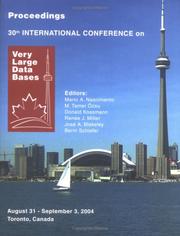
ISBN: 1281370894 9786611370893 0080539793 0120884690 9780080539799 9780120884698 Year: 2004 Publisher: St. Louis, Mo. : Morgan Kaufmann Publishers,
Abstract | Keywords | Export | Availability | Bookmark
 Loading...
Loading...Choose an application
- Reference Manager
- EndNote
- RefWorks (Direct export to RefWorks)
Proceedings of the 30th Annual International Conference on Very Large Data Bases held in Toronto, Canada on August 31 - September 3 2004. Organized by the VLDB Endowment, VLDB is the premier international conference on database technology.
Data structures (Computer science) --- Database management --- Databases
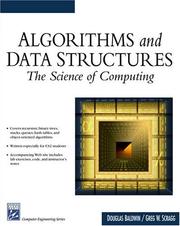
ISBN: 1584502509 9781584502500 Year: 2004 Publisher: Hingham, Mass.: Charles River Media,
Abstract | Keywords | Export | Availability | Bookmark
 Loading...
Loading...Choose an application
- Reference Manager
- EndNote
- RefWorks (Direct export to RefWorks)
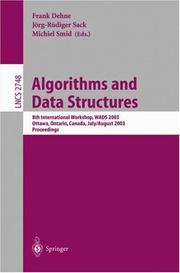
ISSN: 03029743 ISBN: 3540405453 3540450785 9783540405450 Year: 2004 Volume: 2748 Publisher: Berlin : Springer,
Abstract | Keywords | Export | Availability | Bookmark
 Loading...
Loading...Choose an application
- Reference Manager
- EndNote
- RefWorks (Direct export to RefWorks)
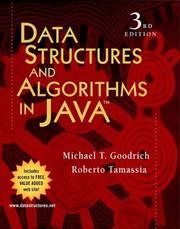
ISBN: 0471469831 9780471469834 Year: 2004 Publisher: Hoboken (N.J.): Wiley,
Abstract | Keywords | Export | Availability | Bookmark
 Loading...
Loading...Choose an application
- Reference Manager
- EndNote
- RefWorks (Direct export to RefWorks)

ISBN: 2100039229 9782100039227 Year: 2004 Publisher: Paris : Dunod,
Abstract | Keywords | Export | Availability | Bookmark
 Loading...
Loading...Choose an application
- Reference Manager
- EndNote
- RefWorks (Direct export to RefWorks)
Electronic digital computers --- Algorithms --- Computer programming --- Computer algorithms --- Computer algorithms. --- Programming --- Structures de données (Informatique) --- Data structures (Computer science) --- Algorithmes --- Programmation (Informatique) --- Electronic digital computers - Programming
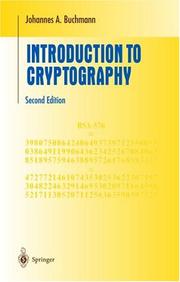
ISBN: 038721156X 0387207562 1441990038 9780387207568 9780387211565 Year: 2004 Publisher: Heidelberg Springer
Abstract | Keywords | Export | Availability | Bookmark
 Loading...
Loading...Choose an application
- Reference Manager
- EndNote
- RefWorks (Direct export to RefWorks)
"Cryptography is a key technology in electronic key systems. It is used to keep data secret, digitally sign documents, access control, etc. Therefore, users should not only know how its techniques work, but they must also be able to estimate their efficiency and security. For this new edition, the author has updated the discussion of the security of encryption and signature schemes and recent advances in factoring and computing discrete logarithms. He has also added descriptions of time-memory trade of attacks and algebraic attacks on block ciphers, the Advanced Encryption Standard, the Secure Hash Algorithm, secret sharing schemes, and undeniable and blind signatures.Johannes A. Buchmann is a Professor of Computer Science and Mathematics at the Technical University of Darmstadt, and the Associate Editor of the Journal of Cryptology. In 1985, he received the Feodor Lynen Fellowship of the Alexander von Humboldt Foundation. Furthermore, he has received the most prestigious award in science in Germany, the Leibniz Award of the German Science Foundation.About the first edition:It is amazing how much Buchmann is able to do in under 300 pages: self-contained explanations of the relevant mathematics (with proofs); a systematic introduction to symmetric cryptosystems, including a detailed description and discussion of DES; a good treatment of primality testing, integer factorization, and algorithms for discrete logarithms; clearly written sections describing most of the major types of cryptosystems....This book is an excellent reference, and I believe it would also be a good textbook for a course for mathematics or computer science majors..." [Neal Koblitz, The American Mathematical Monthly]
cryptografie --- Information systems --- Cryptography --- Coding theory --- Mathematics --- Physical Sciences & Mathematics --- Algebra --- Coding theory. --- Cryptography. --- Codage --- Criptographie --- Cryptographie --- Number theory. --- Data structures (Computer science). --- Number Theory. --- Data Structures and Information Theory. --- Information structures (Computer science) --- Structures, Data (Computer science) --- Structures, Information (Computer science) --- Electronic data processing --- File organization (Computer science) --- Abstract data types (Computer science) --- Number study --- Numbers, Theory of
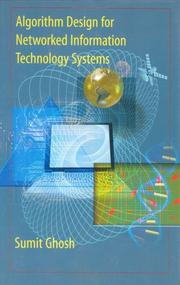
ISBN: 1280189398 9780387216162 9786610189397 0387216162 0387955445 Year: 2004 Publisher: New York : Springer,
Abstract | Keywords | Export | Availability | Bookmark
 Loading...
Loading...Choose an application
- Reference Manager
- EndNote
- RefWorks (Direct export to RefWorks)
Networked information technology (NIT) systems are synonymous with network-centric or net-centric systems and constitute the cornerstone of the fast approaching information age. To date, however, the design and development of NIT systems have been ad hoc and have suffered from a dearth of supporting scientific and theoretical principles. Algorithm Design for Networked Information Technology Systems presents a scientific theory of NIT systems and logically develops the fundamental principles to help synthesize control and coordination algorithms for these systems. The algorithms described are asynchronous, distributed decision-making (ADDM) algorithms, and their characteristics include correct operation, robustness, reliability, scalability, stability, survivability, and performance. The book explains through case studies the conception, development, experimental testing, validation, and rigorous performance analysis of practical ADDM algorithms for real-world systems from a number of diverse disciplines. Topics and features: Develops a logical and practical approach to synthesizing ADDM algorithms for NIT systems Utilizes a scientific method to address the design & testing of NIT systems Incorporates case studies to clearly convey principles and real-world applications Provides a full context for engineers who design, build, deploy, maintain, and refine network-centric systems spanning many human activities Offers background on core principles underlying the nature of network-centric systems NIT systems are critical to new information systems and network- or web-connected control systems in all types of organizations. This new monograph is the first to systematically derive a conceptual foundation for NIT systems and fully present an integrated view of the requisite control and coordination (ADDM) algorithms. Practitioners, professionals, and advanced students will find the book an authoritative resource for the design and analysis of NIT systems algorithms.
Computer algorithms. --- Data structures (Computer science) --- Information networks. --- Operating systems (Computers). --- Computer science. --- Computer software. --- Operating Systems. --- Programming Languages, Compilers, Interpreters. --- Algorithm Analysis and Problem Complexity. --- Programming languages (Electronic computers). --- Algorithms. --- Algorism --- Algebra --- Arithmetic --- Computer languages --- Computer program languages --- Computer programming languages --- Machine language --- Electronic data processing --- Languages, Artificial --- Computer operating systems --- Computers --- Disk operating systems --- Systems software --- Foundations --- Operating systems --- Information structures (Computer science) --- Structures, Data (Computer science) --- Structures, Information (Computer science) --- File organization (Computer science) --- Abstract data types (Computer science) --- Algorithms
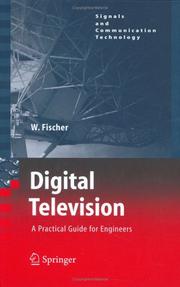
ISBN: 3540011552 3662054310 3662054299 Year: 2004 Publisher: Berlin Springer
Abstract | Keywords | Export | Availability | Bookmark
 Loading...
Loading...Choose an application
- Reference Manager
- EndNote
- RefWorks (Direct export to RefWorks)
Digital Television deals with all present-day TV transmission methods, i.e. MPEG, DVB, ATSC and ISDB-T. The DVD Video is also discussed to some extent. The discussion is focussed on dealing with these subjects in as practical a way as possible. Although mathematical formulations are used, they are in most cases only utilized to supplement the text. The book also contains chapters dealing with basic concepts such as digital modulation or transformations into the frequency domain. A major emphasis is placed on the measuring techniques used on these various digital TV signals. Practical examples and hints concerning measurement are provided. The book starts with the analog TV baseband signal and then continues with the MPEG-2 data stream, digital video, digital audio and the compression methods. After an excursion into the digital modulation methods, all the mentioned transmission methods are discussed in detail. Interspersed between these are found the chapters on the relevant measuring technique.
digitale televisie --- MPEG --- DVD --- DVB --- ISDB-T --- Digital television. --- Digitale televisie --- Digitale televisie. --- Digital television --- Digital communications --- Digital media --- Television --- Electrical engineering. --- Microwaves. --- Optical engineering. --- Data structures (Computer science). --- Communications Engineering, Networks. --- Microwaves, RF and Optical Engineering. --- Electrical Engineering. --- Data Structures and Information Theory. --- Information structures (Computer science) --- Structures, Data (Computer science) --- Structures, Information (Computer science) --- Electronic data processing --- File organization (Computer science) --- Abstract data types (Computer science) --- Mechanical engineering --- Hertzian waves --- Electric waves --- Electromagnetic waves --- Geomagnetic micropulsations --- Radio waves --- Shortwave radio --- Electric engineering --- Engineering
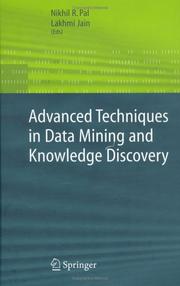
ISBN: 1852338679 9786611180607 1281180602 1846281830 1447157524 Year: 2004 Publisher: New York : Springer-Verlag,
Abstract | Keywords | Export | Availability | Bookmark
 Loading...
Loading...Choose an application
- Reference Manager
- EndNote
- RefWorks (Direct export to RefWorks)
Data mining and knowledge discovery (DMKD) is a rapidly expanding field in computer science. It has become very important because of an increased demand for methodologies and tools that can help the analysis and understanding of huge amounts of data generated on a daily basis by institutions like hospitals, research laboratories, banks, insurance companies, and retail stores and by Internet users. This explosion is a result of the growing use of electronic media. But what is data mining (DM)? A Web search using the Google search engine retrieves many (really many) definitions of data mining. We include here a few interesting ones. One of the simpler definitions is: “As the term suggests, data mining is the analysis of data to establish relationships and identify patterns” [1]. It focuses on identifying relations in data. Our next example is more elaborate: An information extraction activity whose goal is to discover hidden facts contained in databases. Using a combination of machine learning, statistical analysis, modeling techniques and database technology, data mining finds patterns and subtle relationships in data and infers rules that allow the prediction of future results. Typical applications include market segmentation, customer profiling, fraud detection, evaluation of retail promotions, and credit risk analysis [2].
Knowledge acquisition (Expert systems). --- Knowledge acquisition (Expert systems) --- Data mining --- Computer Science --- Engineering & Applied Sciences --- Data mining. --- Acquisition, Knowledge (Expert systems) --- Expertise acquisition (Expert systems) --- Algorithmic knowledge discovery --- Factual data analysis --- KDD (Information retrieval) --- Knowledge discovery in data --- Knowledge discovery in databases --- Mining, Data --- Computer science. --- Data structures (Computer science). --- Algorithms. --- Database management. --- Computer Science. --- Data Structures, Cryptology and Information Theory. --- Data Structures. --- Database Management. --- Information Systems Applications (incl. Internet). --- Algorithm Analysis and Problem Complexity. --- Data base management --- Data services (Database management) --- Database management services --- DBMS (Computer science) --- Generalized data management systems --- Services, Database management --- Systems, Database management --- Systems, Generalized database management --- Electronic data processing --- Algorism --- Algebra --- Arithmetic --- Information structures (Computer science) --- Structures, Data (Computer science) --- Structures, Information (Computer science) --- File organization (Computer science) --- Abstract data types (Computer science) --- Informatics --- Science --- Foundations --- Database searching --- Expert systems (Computer science) --- Data structures (Computer science) --- Computer software. --- Data Structures and Information Theory. --- Software, Computer --- Computer systems --- Data structures (Computer scienc. --- Application software. --- Application computer programs --- Application computer software --- Applications software --- Apps (Computer software) --- Computer software
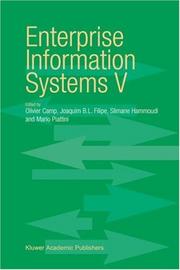
ISBN: 140201726X 9786610147946 1280147946 1402026730 Year: 2004 Publisher: Dordrecht ; Boston : Kluwer Academic,
Abstract | Keywords | Export | Availability | Bookmark
 Loading...
Loading...Choose an application
- Reference Manager
- EndNote
- RefWorks (Direct export to RefWorks)
This book comprises a set of papers selected from those presented at the fifth « International Conference on Enterprise Information Systems », (ICEIS’2003) held in Angers, France, from 23 to 26 April 2003. The conference was organised by École Supérieure d’Électronique de l’Ouest (ESEO) of Angers, France and the Escola Superior de Tecnologia of Setúbal, Portugal. Since its first edition in 1999, ICEIS focuses on real world applications and aims at bringing together researchers, engineers and practitioners interested in the advances and business applications of information systems. As in previous years, ICEIS’2003 held four simultaneous tracks covering different aspects of enterprise computing: Databases and Information Systems Integration, Artificial Intelligence and Decision Support Systems, Information Systems Analysis and Specification and Software Agents and Internet Computing. Although ICEIS’2003 received 546 paper submissions from over 50 countries, only 80 were accepted as full papers and presented in 30-minutes oral presentations. With an acceptance rate of 15%, these numbers demonstrate the intention of preserving a high quality forum for future editions of this conference. From the articles accepted as long papers for the conference, only 32 were selected for inclusion in this book Additional keynote lectures, tutorials and industrial sessions were also held during ICEIS’2003, and, for the first time this year, the 1st Doctoral Consortium on Enterprise Information Systems gave PhD students an opportunity to present their work to an international audience of experts in the field of information systems.
Management information systems --- Information storage and retrieval systems --- Computer science. --- Leadership. --- Software engineering. --- Data structures (Computer science). --- User interfaces (Computer systems). --- Artificial intelligence. --- Computer Science. --- Artificial Intelligence (incl. Robotics). --- Business Strategy/Leadership. --- Software Engineering/Programming and Operating Systems. --- Data Structures, Cryptology and Information Theory. --- User Interfaces and Human Computer Interaction. --- Information Systems Applications (incl. Internet). --- Data structures (Computer scienc. --- Artificial Intelligence. --- Data Structures and Information Theory. --- Data structures (Computer science) --- Information structures (Computer science) --- Structures, Data (Computer science) --- Structures, Information (Computer science) --- Electronic data processing --- File organization (Computer science) --- Abstract data types (Computer science) --- Computer software engineering --- Engineering --- Informatics --- Science --- Ability --- Command of troops --- Followership --- AI (Artificial intelligence) --- Artificial thinking --- Electronic brains --- Intellectronics --- Intelligence, Artificial --- Intelligent machines --- Machine intelligence --- Thinking, Artificial --- Bionics --- Cognitive science --- Digital computer simulation --- Logic machines --- Machine theory --- Self-organizing systems --- Simulation methods --- Fifth generation computers --- Neural computers --- Application software. --- Application computer programs --- Application computer software --- Applications software --- Apps (Computer software) --- Computer software --- Interfaces, User (Computer systems) --- Human-machine systems --- Human-computer interaction
| Listing 1 - 10 of 63 | << page >> |
Sort by
|

 Search
Search Feedback
Feedback About UniCat
About UniCat  Help
Help News
News